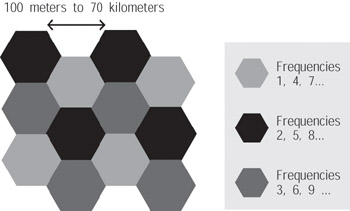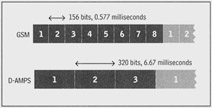GSM and TDMA Cellular Networks
| |
Cellular networks have traditionally been the preserve of voice, a tradition set to change over the next few years . Most cell phones worldwide already have the ability to send and receive short text messages, and an increasing number now incorporate more advanced Internet capabilities. However, how far can existing infrastructure take the wireless Internet? To understand this, it's necessary to explore how today's mobile phone systems work.
Despite the marketing terms used by different operators, all mobile systems except point-to-point radio are cellular: they divide their coverage area into cells , at the center of which sits a Base Transceiver Station (BTS).
Each operator is licensed by government to use only a small slice of the available radio spectrum (typically around 20MHz), but no single BTS can use more than one third of this slice. This is because adjacent cells would interfere with each other if they used the same frequencies, so at least three different radio channels are needed. The most efficient cell arrangement uses a honeycomb pattern, as shown in Figure 1.

Figure 1: In an ideal cellular network, hexagonal cells are arranged in a honeycomb structure, each using a third of the available spectrum to prevent interference.
The simplest cellular systems use Frequency Division Multiplexing (FDM), which gives each conversation its own waveband, just like a radio station. For example, the analog American Mobile Phone System (AMPS), still the most widely used wireless standard in the United States, gives each user 30KHz. This limits the number of calls to the number of 30KHz frequencies available: If an operator has a license for 10MHz of spectrum, it can support at most 111 calls per cell.
It's possible to increase capacity by making cells smaller, but this is expensive and perhaps dangerous. Current technology also limits cell diameters to at least 100 meters (330 feet) because the internal circuitry of a BTS generates so much radiation that it would interfere with very low power transmissions. The only way to carry more traffic without building more cells is to pack more calls into a single frequency. This means that the voice must be converted into data.
Time Off
There are at least three ways to share a frequency, the simplest of which is further FDM. The trouble with this, as radio listeners know, is that nearby frequencies interfere with each other.
A second (and more sophisticated) approach is Code Division Multiple Access (CDMA), recently developed by Qualcomm. CDMA encodes each transmission to provide, in theory, unlimited capacity-it will form the basis of future broadband systems.
Finally, most existing mobile data networks use Time Division Multiple Access (TDMA), a method by which each conversation only uses a frequency for part of the time.
To most U.S. consumers, TDMA means a particular mobile system, the one technically known as the Digital-American Mobile Phone System (D-AMPS) or IS-136. However, to engineers , this is just one among many TDMA technologies. The most important is Global System for Mobile Communications (GSM), the cell phone standard developed by European governments in the 1980s. GSM now accounts for more than half the world's mobile market.
TDMA also forms the basis of both Personal Digital Cellular (PDC), the second-most-popular mobile standard (even though it's only used in Japan), and Motorola's proprietary Integrated Digital Enhanced Network (IDEN).
All TDMA systems work by dividing a frequency into a number of time slots, each of which corresponds to one communication channel. A cell phone transmits and receives in only one slot, remaining silent until its turn comes around again. This means that a D-AMPS phone only transceives for one-third of the time, and a GSM for one- eighth (see Figure 2). The number of slots, the cycle length, and the frequency width all depend on the particular technology: As shown in Table 1, GSM uses wider frequencies than the others, with much shorter time slots.

Figure 2: The Global System for Mobile Communications (GSM) multiplexing scheme uses eight time slots, compared to Digital-American Mobile Phone System's (D-AMPS) three.
GSM's wide frequencies give it scalability advantages, but the short time slots cause problems in keeping phones synchronized with each other. Radio signals take just over 0.003 microsecond to travel a kilometer (km), which adds up to a round-trip delay of around 0.4 microsecond for a phone only 60 km (40 miles) from the base station. The time slot only lasts 0.577 microsecond, so this delay is enough to make the phone miss its slot entirely, even though it would be unnoticeable to a human listener. In practice, GSM phones cannot be used more than 35 km (22 miles) from a BTS, no matter how strong the signal.
Each 0.577-microsecond GSM time slot carries 156 bits, which in theory amounts to a capacity of 33.8Kbits/sec for each of the eight channels. Unfortunately, most of this is not available for data applications. The GSM protocol is very wasteful in terms of its overhead, requiring a lot of bandwidth for such functions as signaling and cryptography. To prevent eavesdroppers, every transmission is encrypted using a secret algorithm known as A5, which is thought to use keys of up to 56 bits.
The raw bandwidth of a D-AMPS channel is only 16Kbits/sec, of which much less is used for protocol overhead. This is partly because it doesn't include strong encryption, thanks to U.S. export regulations. Another reason is that call setup and location monitoring are handled by a separate analog channel, for compatibility with the older AMPS networks.
TDMA Technologies
| Time Division Multiple Access (TDMA) technology | Frequency width | Number of slots | Slot length | Bits per slot | Cycles per second | Coverage |
|---|---|---|---|---|---|---|
| Global System for Mobile Communications (GSM) | 200KHz | 8 | 0.577 microsecond | 156 | 217 | Worldwide |
| Digital-American Mobile Phone System (D-AMPS) | 30KHz | 3 | 6.67 microseconds | 320 | 50 | America |
| Personal Digital Cellular (PDC) | 25KHz | 3 | 6.67 microseconds | 430 | 50 | Japan |
| Integrated Digital Enhanced Network (IDEN) | 25KHz | 6 | 7.25 microseconds | 464 | 23 | America |
Data Delays
On the wired telephone network, toll-quality voice requires a full DS0 channel, operating at 64Kbits/sec. Cellular systems don't have this kind of capacity, so the bitstream has to be compressed. Each technology has its own codec ( coder /decoder), and as with all compression, there is a tradeoff between quality and compactness.
GSM's codec gives the best results, producing a 260-bit packet every 20 milliseconds (ms) for a data rate of 13Kbits/sec. The D-AMPS codec requires only 8Kbits/sec, which is lower quality but still intelligible. Vendors have recently developed "half-rate" codecs for both systems, which aim to double the voice capacity of a network, though so far these are rarely used.
However, a cell phone can't just transmit the raw output of its codec. Wireless networks suffer from interference caused by everything from cosmic rays to microwave ovens, and they need some way to ensure that data arrives intact. Both GSM and D-AMPS use Forward Error Correction (FEC), which enables the bits judged most important to be recovered without retransmission if they are lost. GSM's algorithm is again the more sophisticated and bandwidth-hungry: including FEC, its speech rate climbs to 22.4Kbits/sec, compared to only 13Kbits/sec for D-AMPS.
The earliest schemes for sending data over mobile networks had to route it through the voice codec, reducing capacity to around 5Kbits/sec. However, recent upgrades to both GMC and D-AMPS enable data to bypass the codec entirely, as well as some of the error correction, pushing the rate to 14.4Kbits/sec over GSM and 9.6Kbits/sec over D-AMPS (see Table 2). Data traffic is actually more tolerant of errors than highly compressed voice because it doesn't matter in which order packets arrive .
Bandwidth Allocation
| |
 |
| |
To increase data capacity further, carriers are turning to two new technologies: High Speed Circuit Switched Data (HSCSD) and General Packet Radio Service (GPRS). They were intended for GSM but can also be applied in a more limited way to D-AMPS and PDC systems.
Both technologies grant each channel access to more than one time slot in the multiplex . GPRS also adds packet-switching to use bandwidth more efficiently and permit "always-on" connections.
Regular GSM calls use only one slot out of eight, so in theory GPRS could provide an eightfold acceleration to 115Kbits/sec. However, the first GPRS services, expected in Europe by early 2001, will only offer a fraction of this rate. The main reason is that a full-speed device would generate too much microwave radiation, overheating the phone and possibly threatening the user's health.
The problems for GPRS over D-AMPS and PDC are even more serious. These only use three slots, compared to GSM's eight, limiting the maximum bandwidth to only 28.8Kbits/sec. This means that while Europe's existing cellular system will eventually be upgraded to ISDN speeds, American mobile operators who want landline performance will have to roll out entirely new networks.
Resources
The Global System for Mobile Communications (GSM) Association, a Dublin, Ireland-based alliance of GSM operators and vendors, is located at www.gsmworld.com.
Intel runs two Web sites designed to aid anyone wanting to send data over digital cellular networks. The sites contain many articles on existing and future wireless systems. Intel has an obvious interest in promoting data applications but is not tied to any particular phone technology or vendor. Go to www.gsmdata.com and www.pcsdata.com.
This tutorial, number 141, by Andy Dornan, was originally published in the April 2000 issue of Network Magazine.
| |
EAN: 2147483647
Pages: 193